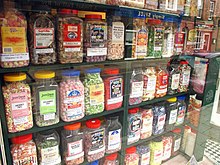 Butterscotch sweets | |
| Type | Confectionery |
|---|---|
| Place of origin | England |
| Region or state | Doncaster, Yorkshire |
| Main ingredients | Brown sugar, butter |
Butterscotch is a type of confectionery whose primary ingredients are brown sugar and butter. Some recipes include corn syrup, cream, vanilla, and salt. The earliest known recipes, in mid-19th century Yorkshire, used treacle (molasses) in place of, or in addition to, sugar.
Butterscotch is similar to toffee, but the sugar is boiled to the soft crack stage, not hard crack.[1] Often credited with their invention, S. Parkinson & Sons of Doncaster made butterscotch boiled sweets and sold them in tins, which became one of the town's best-known exports.[2] They became famous in 1851 after Queen Victoria was presented with a tin when she visited the town.[3] Butterscotch sauce, made of butterscotch and cream, is used as a topping for ice cream (particularly sundaes).
The term "butterscotch" is also often used more specifically for the flavour of brown sugar and butter together, even if the actual confection butterscotch is not involved, such as in butterscotch pudding (a type of custard).
Etymology
[edit]Food historians have several theories regarding the name and origin of this confectionery, but none is conclusive. One explanation is the meaning "to cut or score" for the word "scotch", as the confection must be cut into pieces, or "scotched", before hardening.[4][5] The "scotch" part of its name possibly was derived from the word "scorch".[6] In 1855, F. K. Robinson's Glossary of Yorkshire Words explained Butterscotch as "a treacle ball with an amalgamation of butter in it".[7]
History
[edit]
Early mentions of butterscotch associate the confection with Doncaster in Yorkshire. An 1848 issue of the Liverpool Mercury gave a recipe for "Doncaster butterscotch" as "one pound of butter, one pound of sugar and a quarter of a pound of treacle, boiled together" (500 g each of butter and sugar and 125 g treacle).[8]
By 1851, Doncaster butterscotch was sold commercially by rival confectioners S. Parkinson & Sons (the original Parkinson recipe is still made today[disputed – discuss][9]), Henry Hall, and Booth's via agents elsewhere in Yorkshire.[10][11][12] Parkinson's started to use and advertise the Doncaster Church as their trademark.[13] It was advertised as "Royal Doncaster Butterscotch", or "The Queen's Sweetmeat", and said to be "the best emollient for the chest in the winter season".[14] Parkinson's Butterscotch was by appointment to the royal household and was presented to the Princess Elizabeth, then the Duchess of Edinburgh, in 1948[15] and to Anne, Princess Royal in 2007.[16] In the late 19th and early 20th centuries, the British sweet became popular in the U.S.[17]
Packaging and products
[edit]
Butterscotch is often used as a flavour for items such as dessert sauce, pudding, and biscuits (cookies). To that end, it can be bought in "butterscotch chips" made with hydrogenated (solid) fats to be similar for baking use to chocolate chips.
Also, individually wrapped, translucent yellow hard candies (butterscotch disks) are made with an artificial butterscotch flavour. In addition, butterscotch-flavoured liqueur is in production.
Champion and Reeves make luxury traditional butterscotch in Shropshire, with British butter and British double cream, wrapped in individual foil wrappers.
Tastykake makes a cake known as a Krimpet. Butterscotch is a popular flavour that is offered.
Sauce
[edit]Butterscotch sauce is made of brown sugar cooked to 240 °F (116 °C) mixed with butter and cream.[18]
See also
[edit]References
[edit]- ^ "The Cold Water Candy Test". Exploratorium. Retrieved 12 January 2014.
- ^ Chrystal, Paul (2013). Confectionery in Yorkshire Through Time. Amberley Publishing Limited.
- ^ "Doncaster's Proud History". Doncaster Free Press. 7 October 2017. Archived from the original on 8 October 2017. Retrieved 7 October 2017.
- ^ "Maple Sugar". baking911.com. Archived from the original on 10 November 2011. Retrieved 5 May 2012.
- ^ "Butterscotch Sauce Recipe, How to Make Butterscotch | Simply Recipes". Elise.com. Archived from the original on 18 May 2009. Retrieved 5 May 2012.
- ^ "Sticking With Butterscotch". Washington Post. 7 March 2007. Retrieved 10 July 2014.
- ^ "Butterscotch". Oxford English Dictionary.
- ^ "Housewife's Corner". Liverpool Mercury. 1 February 1848. p. 4.
- ^ "Parkinson's Doncaster Butterscotch" Archived 13 December 2007 at the Wayback Machine. Doncaster Butterscotch.com.
- ^ Sheffield & Rotherham Independent. 20 December 1851.
- ^ Sheffield & Rotherham Independent. 27 December 1851.
- ^ Bradford Observer. 21, 1856
- ^ Observer (New Zealand), Volume IX, Issue 570, 30 November 1889, Page 3.
- ^ Leeds Mercury. 29 January 1853.
- ^ "Royals visit 1948 St Leger – Features". The Star. 29 August 2008. Archived from the original on 7 October 2017. Retrieved 5 May 2012.
- ^ "travel". Best Doncaster Airport Hotels. 5 March 2004. Archived from the original on 11 April 2011. Retrieved 5 May 2012.
- ^ Hopkins, Kate (2012). Sweet Tooth: The Bittersweet History of Candy. St. Martin's Press. p. 170.
- ^ Wayne Gisslen, Professional Baking, ISBN 1118254368, p. 227.